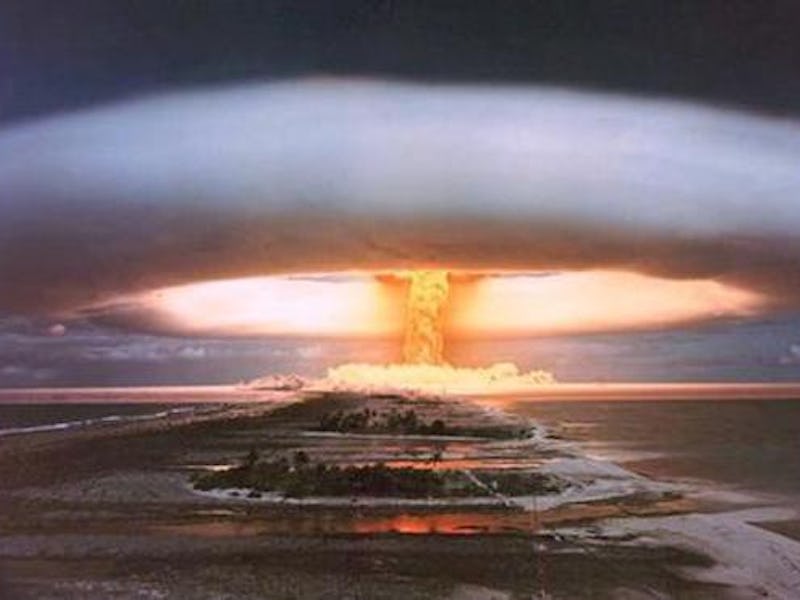What's the Difference Between Atomic and Hydrogen Bombs?
They're both bad, but one's worse than the other.

Not since the height of the Cold War have people been so worried about the end of the world. There are surprise military strikes from Washington — the latest on Thursday when America dropped its biggest non-nuclear bomb for the first time — along with the return of tensions between Russia and the U.S.
Perhaps most alarmingly, North Korea is kicking its atomic brinksmanship into high gear. When it comes to Pyongyang, it’s important to consider an important and often misunderstood distinction: the difference between atomic bombs and hydrogen bombs — technically speaking, the difference between pure fission bombs and thermonuclear weapons.
Pure fission bombs, colloquially known as atomic bombs, release a tremendous amount of energy by splitting atomic nuclei in two in a chain reaction. This is the type of bomb originally developed by the Manhattan Project and later dropped on Hiroshima and Nagasaki, achieving explosive yield equivalent to 13 to 22 kilotons of TNT in those instances.
These bombs come in two main forms. Gun-type explodes one lump of super-enriched nuclear material into another hard enough to create a nuclear reaction. Implosion-type collapses a hollow sphere of nuclear material to produce the same effect much more accurately and while using less material.
What happens in a fission bomb is a far less restrained version of what happens in a reactor at a nuclear power station. By enriching the sample far beyond the level necessary for power production, and by starting the reaction more violently, however, the cascade of fission reactions progresses quickly enough to create a nuclear explosion of the sort seen at Hiroshima and Nagasaki.
A photo of the nuclear mushroom cloud over Nagasaki, in 1945.
Thermonuclear weapons, colloquially known as hydrogen bombs, release a potentially far greater amount of energy by combining two or more atomic nuclei into a lower-energy form. They’re often called hydrogen bombs since the materials fused are typically hydrogen isotopes like deuterium and tritium.
Somewhat confusingly, all extant thermonuclear weapons include a fission reaction, which is used to set off the fusion reaction (these bombs are described as staged thermonuclear weapons because of the multiple stages involved). A pure fusion bomb, on the other hand, is theoretically possible but hasn’t been invented.
A thermonuclear blast can be thousands of times more destructive than pure fission explosion. Case in point: America’s Castle Bravo H-bomb test in 1954 registered 15,000 kilotons of TNT.
Below is a video of Castle Bravo, America’s biggest-ever test.
Even Castle Bravo isn’t the biggest nuke the world has ever seen. That infamous title goes to Tsar Bomba, a Soviet H-bomb tested in 1961 that registered 50,000 kilotons of TNT.
Fusion bombs can be designed to release less radiation than fission bombs, though they can also be designed to do the opposite. The infamous neutron bomb is a hydrogen bomb with a suppressed explosive yield and maximized output of radioactive neutrons, which can be deadly to people but disperse relatively quickly. This bomb suggests the chilling possibility of a strike that knocks out a population but leaves infrastructure relatively intact.
As for what kind of bomb North Korea is sitting on and threatening to use, there’s still some mystery. The rogue dictatorship has had five successful tests of nuclear weapons — in 2006, 2009, 2013, January 2016, and September 2016 — though experts are skeptical about claims that its January 2016 test was a thermonuclear bomb. In yield, the bomb tests have ranged from 2 to 35 kilotons of TNT.
There’s also the question of whether North Korea has miniaturized its weapons enough to fire them on a missile. Siegfried S. Hecker of Stanford University, a leading authority on the subject, has said it’s fair to assume the country can mount warheads on “some of its short-range and perhaps medium-range missiles,” with the ability to fire them on intercontinental ballistic missiles and target the US “still long way off — perhaps 5 to 10 years.”
Globally, there are an estimated 14,900 nuclear weapons. Although that number has declined by over two-thirds since the mid-1980s thanks to disarmament programs, that’s more than enough out there to destroy the world — and, between rogue states, militaristic states, and non-state actors who might just get their hands on a nuke, the risk of someone using them isn’t exactly declining.